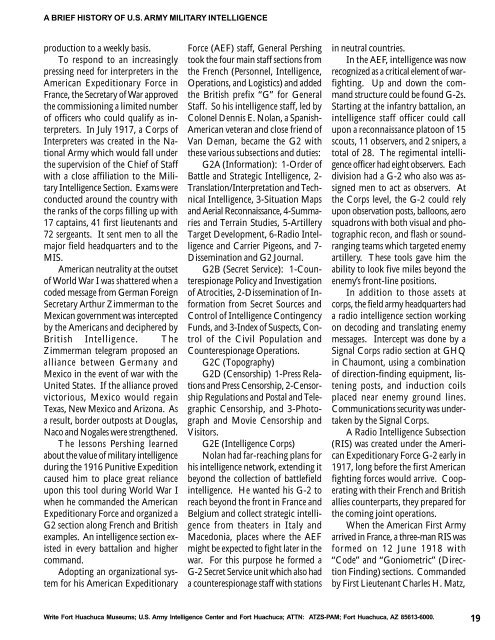Brief History of Army MI - Fort Huachuca - U.S. Army
Brief History of Army MI - Fort Huachuca - U.S. Army
Brief History of Army MI - Fort Huachuca - U.S. Army
You also want an ePaper? Increase the reach of your titles
YUMPU automatically turns print PDFs into web optimized ePapers that Google loves.
A BRIEF HISTORY OF U.S. ARMY <strong>MI</strong>LITARY INTELLIGENCEproduction to a weekly basis.To respond to an increasinglypressing need for interpreters in theAmerican Expeditionary Force inFrance, the Secretary <strong>of</strong> War approvedthe commissioning a limited number<strong>of</strong> <strong>of</strong>ficers who could qualify as interpreters.In July 1917, a Corps <strong>of</strong>Interpreters was created in the National<strong>Army</strong> which would fall underthe supervision <strong>of</strong> the Chief <strong>of</strong> Staffwith a close affiliation to the MilitaryIntelligence Section. Exams wereconducted around the country withthe ranks <strong>of</strong> the corps filling up with17 captains, 41 first lieutenants and72 sergeants. It sent men to all themajor field headquarters and to the<strong>MI</strong>S.American neutrality at the outset<strong>of</strong> World War I was shattered when acoded message from German ForeignSecretary Arthur Zimmerman to theMexican government was interceptedby the Americans and deciphered byBritish Intelligence. TheZimmerman telegram proposed analliance between Germany andMexico in the event <strong>of</strong> war with theUnited States. If the alliance provedvictorious, Mexico would regainTexas, New Mexico and Arizona. Asa result, border outposts at Douglas,Naco and Nogales were strengthened.The lessons Pershing learnedabout the value <strong>of</strong> military intelligenceduring the 1916 Punitive Expeditioncaused him to place great relianceupon this tool during World War Iwhen he commanded the AmericanExpeditionary Force and organized aG2 section along French and Britishexamples. An intelligence section existedin every battalion and highercommand.Adopting an organizational systemfor his American ExpeditionaryForce (AEF) staff, General Pershingtook the four main staff sections fromthe French (Personnel, Intelligence,Operations, and Logistics) and addedthe British prefix “G” for GeneralStaff. So his intelligence staff, led byColonel Dennis E. Nolan, a Spanish-American veteran and close friend <strong>of</strong>Van Deman, became the G2 withthese various subsections and duties:G2A (Information): 1-Order <strong>of</strong>Battle and Strategic Intelligence, 2-Translation/Interpretation and TechnicalIntelligence, 3-Situation Mapsand Aerial Reconnaissance, 4-Summariesand Terrain Studies, 5-ArtilleryTarget Development, 6-Radio Intelligenceand Carrier Pigeons, and 7-Dissemination and G2 Journal.G2B (Secret Service): 1-CounterespionagePolicy and Investigation<strong>of</strong> Atrocities, 2-Dissemination <strong>of</strong> Informationfrom Secret Sources andControl <strong>of</strong> Intelligence ContingencyFunds, and 3-Index <strong>of</strong> Suspects, Control<strong>of</strong> the Civil Population andCounterespionage Operations.G2C (Topography)G2D (Censorship) 1-Press Relationsand Press Censorship, 2-CensorshipRegulations and Postal and TelegraphicCensorship, and 3-Photographand Movie Censorship andVisitors.G2E (Intelligence Corps)Nolan had far-reaching plans forhis intelligence network, extending itbeyond the collection <strong>of</strong> battlefieldintelligence. He wanted his G-2 toreach beyond the front in France andBelgium and collect strategic intelligencefrom theaters in Italy andMacedonia, places where the AEFmight be expected to fight later in thewar. For this purpose he formed aG-2 Secret Service unit which also hada counterespionage staff with stationsin neutral countries.In the AEF, intelligence was nowrecognized as a critical element <strong>of</strong> warfighting.Up and down the commandstructure could be found G-2s.Starting at the infantry battalion, anintelligence staff <strong>of</strong>ficer could callupon a reconnaissance platoon <strong>of</strong> 15scouts, 11 observers, and 2 snipers, atotal <strong>of</strong> 28. The regimental intelligence<strong>of</strong>ficer had eight observers. Eachdivision had a G-2 who also was assignedmen to act as observers. Atthe Corps level, the G-2 could relyupon observation posts, balloons, aerosquadrons with both visual and photographicrecon, and flash or soundrangingteams which targeted enemyartillery. These tools gave him theability to look five miles beyond theenemy’s front-line positions.In addition to those assets atcorps, the field army headquarters hada radio intelligence section workingon decoding and translating enemymessages. Intercept was done by aSignal Corps radio section at GHQin Chaumont, using a combination<strong>of</strong> direction-finding equipment, listeningposts, and induction coilsplaced near enemy ground lines.Communications security was undertakenby the Signal Corps.A Radio Intelligence Subsection(RIS) was created under the AmericanExpeditionary Force G-2 early in1917, long before the first Americanfighting forces would arrive. Cooperatingwith their French and Britishallies counterparts, they prepared forthe coming joint operations.When the American First <strong>Army</strong>arrived in France, a three-man RIS wasformed on 12 June 1918 with“Code” and “Goniometric” (DirectionFinding) sections. Commandedby First Lieutenant Charles H. Matz,Write <strong>Fort</strong> <strong>Huachuca</strong> Museums; U.S. <strong>Army</strong> Intelligence Center and <strong>Fort</strong> <strong>Huachuca</strong>; ATTN: ATZS-PAM; <strong>Fort</strong> <strong>Huachuca</strong>, AZ 85613-6000.19
















